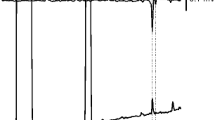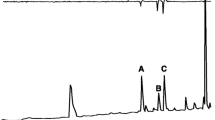Abstract
The sex pheromones of two species of hawk moth, Deilephila elpenor lewisii (Butler) and Theretra oldenlandiae oldenlandiae (Fabricius), were analyzed using gas chromatography–electroantennographic detection (GC–EAD) and GC–mass spectrometry (GC–MS). Two and three EAD-active components were found in D. elpenor lewisii and T. oldenlandiae oldenlandiae, respectively. GC–MS analyses using authentic compounds and extracts derivatized by dimethyl disulfide and 4-methyl-1,2,4-triazoline-3,5-dione identified the two components in D. elpenor lewisii as (E)-11-hexadecenal (E11–16:Ald) and (10E,12E)-10,12-hexadecadienal (E10,E12–16:Ald), and the three in T. oldenlandiae oldenlandiae as E11–16:Ald, E10,E12–16:Ald, and (10E,12Z)-10,12-hexadecadienal (E10,Z12–16:Ald). In field-trap tests, no males of either species were attracted to any single components. Male moths of D. elpenor lewisii were specifically attracted to a binary blend of E11–16:Ald and E10,E12–16:Ald at a ratio of 85:15, whereas males of T. oldenlandiae oldenlandiae were attracted to a ternary blend of E11–16:Ald, E10,Z12–16:Ald and E10,E12–16:Ald at a ratio of 30:40:30. We therefore conclude that the sex pheromone of D. elpenor lewisii is a mixture of E11–16:Ald and E10,E12–16:Ald and that of T. oldenlandiae oldenlandiae is E11–16:Ald, E10,Z12–16:Ald and E10,E12–16:Ald.

Similar content being viewed by others
References
Ando T, Ogura Y, Uchiyama M (1988) Mass spectra of lepidopterous sex pheromones with a conjugated diene system. Agric Biol Chem 52:1415–1423
Ando T, Ohtani K, Yamamoto M, Miyamoto T, Qin X, Witjaksono K (1997) Sex pheromone of Japanese giant looper, Ascotis selenaria cretacea: identification and field tests. J Chem Ecol 23:2413–2423
Bestmann HJ, Erler J, Gerbe W, Kern F, Martischonok V, Schäfer D, Vostrowsky O, Wasserthal LT (1992) Pheromone components of the female elephant hawk-moth, Deilephila elpenor, and silver-striped hawk-moth, Hippotion celerio. Experimentia 48:610–613
Buser HR, Arn H, Guerin P, Rauscher S (1983) Determination of double bond position in mono-unsaturated acetates by mass spectrometry of dimethyl disulfide adducts. Anal Chem 55:818–822
Cork A, Chamberlain DJ, Beevor PS, Hall DR, Nesbitt BF, Campion DG, Attique MR (1988) Components of female sex pheromone of spotted bollworm, Earias vittella F. (Lepidoptera: Noctuidae): identification and field evaluation in Pakistan. J Chem Ecol 14:929–945
Daimon T, Fujii T, Yago M, Hsu Y, Nakajima Y, Fujii T, Katsuma S, Ishikawa Y, Shimada T (2012) Female sex pheromone and male behavioral responses of the bombycid moth Trilocha varians: comparison with those of the domesticated silkmoth Bombyx mori. Naturwissenschaften 99:207–215
Honda H, Himeno K, Yoshiyasu Y (1994) Chemotaxonomy of the cotton leaf-roller (Lepidoptera: Pyralidae) in Japan with special reference to differences in sex pheromones. Appl Entamol Zool 29:323–330
Japanese Society of Applied Entomology and Zoology (2006) Major insect and other pests of economic plants in Japan (revised edition). The Japanese Society of Applied Entomology and Zoology, Tokyo, p 381
Kakizaki M, Sugie H (2002) Sex pheromone of the flax bidworm, Heliothis maritime adaucta Butler (Lepidoptera: Noctuidae). Appl Entamol Zool 38:73–78
Klun JA, Leonhardt BA, Schwarz M, Day A, Raina AK (1986) Female sex pheromone of the pickleworm, Diaphania nitidalis (Lepidoptera: Pyralidae). J Chem Ecol 12:239–249
Landolt PJ, Tumlinson JH, Brennan MM (1989) Attraction of Amphion floridensis (Lepidoptera: Sphingidae) to bombykal, (E,Z)-10,12-hexadecadienal. Fla Entamol 72:324–327
Linn CE, Roelofs WL (1995) Pheromone communication in moths and its role in the speciation process. In: Lambert DM, Spencer HG (eds) Speciation and the recognition concept. Johns Hopkins University Press, Baltimore, pp 263–300
McElfresh JS, Millar JG (1999a) Geographic variation in sex pheromone blend of Hemileuca electra from southern California. J Chem Ecol 25:2505–2525
McElfresh JS, Millar JG (1999b) Sex pheromone of the common sheep moth, Hemileuca eglanterina, from the San Gabriel Mountains on California. J Chem Ecol 25:687–709
McElfresh JS, Hammond AM, Millar JG (2001) Sex pheromone components of the buck moth Hemileuca maia. J Chem Ecol 27:1409–1422
Pittaway AR (1993) The hawkmoths of the western palaearctic. Harley books, Colchester, pp 156–157
Raina AK, Klun JA, Schwarz M, Day A, Leonhardt BA, Douglass LW (1986) Female sex pheromone of the melonworm, Diaphania hyalinata (Lepidoptera: Pyralidae), and analysis of male responses to pheromone in a flight tunnel. J Chem Ecol 12:229–237
Reed DW, Underhill EW, Giblin EM (1987) Attraction of sphingid moths (Lepidoptera: Sphindidae) to 10, 12-hecadecadienyl aldehydes and acetates: evidence of pheromone components. J Chem Ecol 13:931–942
Starratt AN, Dahm KH, Allen N, Hildebrand JG, Payne TL, Roller H (1979) Bombykal, a sex pheromone of the sphinx moth Manduca sexta. Z Naturforsch 34:9–12
Tamaki Y (1977) Complexity, diversity, and specificity of behavior-modifying chemicals in Lepidoptera and Diptera. In: Shorey HH, Mckelvey JJ Jr (eds) Chemical control of insect behavior. Wiley, NY, pp 253–285
Tumlinson JH, Mitchell ER, Doolittle RE, Jackson DM (1994) Field tests of synthetic Manduca sexta sex pheromone. J Chem Ecol 20:579–591
Uehara T, Naka H, Matsuyama S, Ando T, Honda H (2011) Sex pheromone diversity in Japanese hawkmoth. Asia-Pacific Association of Chemical Ecology, NY, p 122
Wakamura S, Yasuda T, Watanabe M, Kiguchi K, Shimoda M, Ando T (1996) Sex pheromone of the sweetpotato hornworm, Agrius convolvuli (L.) (Lepidoptera: Sphingidae): identification of a major component and its activity in a wind tunnel. Appl Entamol Zool 31:171–174
Young DC, Vouros P, Holick MF (1990) Gas chromatography–mass spectrometry of conjugated dienes by derivatization with 4-methyl-1,2,4-triazoline-3,5-dione. J Chromatogr 522:295–302
Acknowledgments
We thank ShinEtsu Chemical Co., Ltd. for supplying synthetic monoenyl aldehydes and Dr. DeMar Taylor for helpful improvement in the manuscript. We also thank Mr. Takahiro Yano for offering important information about rearing and field experiments in Deilephila elpenor. We are grateful to Mr. T. Morita, Ms. K. Ohbayashi, and students of the Laboratory of Applied Entomology in Faculty of Agriculture at Tottori University for their help with field experiments and rearing insects.
Author information
Authors and Affiliations
Corresponding author
Rights and permissions
About this article
Cite this article
Uehara, T., Naka, H., Matsuyama, S. et al. Identification and field evaluation of sex pheromones in two hawk moths Deilephila elpenor lewisii and Theretra oldenlandiae oldenlandiae (Lepidoptera: Sphingidae). Appl Entomol Zool 47, 227–232 (2012). https://doi.org/10.1007/s13355-012-0111-0
Received:
Accepted:
Published:
Issue Date:
DOI: https://doi.org/10.1007/s13355-012-0111-0




